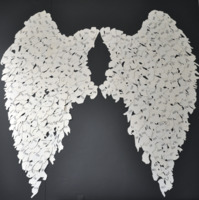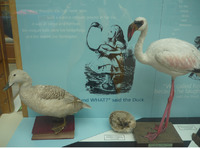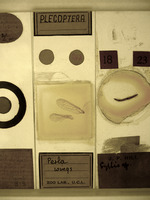Items
Site
The Medicine Chest
keywords is exactly
Natural History Museum
-

Pisces (Platichthys Fleus)
Addressing the fact that 95% of known animal species are smaller than our thumbs, yet natural history museums displays are filled with mostly large animals, this sub-museum shows the legs of a flea highlighting its muscles; a whole squid, just a couple of millimetres long; beetles that have been sliced along their entire length, through the antennae, head, legs and body — 1/10th of a millimetre thick; as well as these two baby flounder fish. -

Mary Anning
Henry De la Beche's portrait of Mary Anning, the English fossil collector, dealer, and palaeontologist who became known around the world for finds she made in the cliffs along the English Channel at Lyme Regis. These cliffs consisted of alternating layers of limestone and shale, laid down as sediment on a shallow seabed early in the Jurassic period (about 210 - 195 million years ago). As a woman, Anning was treated as an outsider to the scientific community. The increasingly influential Geological Society of London did not allow women to become members, or even to attend meetings as guests. -

Wings
512 lasercut hands derived from images of healing: 2500 BC - 2000 AD. -

Museum of Natural History Oxford
On a sunny afternoon, July 4th 1862, an Oxford don took out four friends, for a rowing expedition up the Thames. The don was the Oxford mathematician, photographer and storyteller, Charles Dodgeson (better known by his pen name, Lewis Carroll) and his friends were the Rev. Robinson Duckworth and three children – Alice Liddell, aged 10, and her sisters. During the afternoon Dodgeson spun out a series of fantastic yarns incorporating friends and familiar places in Oxford, mathematical riddles, literary allusions and countless references to natural history. -

Tabloid
"The brand name ‘Tabloid’, however, stayed associated with things ‘reduced in size or compressed’ (Larson 2009: 86). It is this reduction in size that made the firm’s drugs perfect for travel, and the medicine chests in particular were designed to this end" (Liebenberg 2021: 45). -

Perla Wings
Addressing the fact that 95% of known animal species are smaller than our thumbs, yet natural history museums displays are filled with mostly large animals, this sub-museum shows the legs of a flea highlighting its muscles; a whole squid, just a couple of millimetres long; beetles that have been sliced along their entire length, through the antennae, head, legs and body – 1/10th of a millimetre thick; as well as the wings of a Chrysopa perla, a fearsome predator in the insect world.


